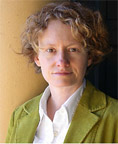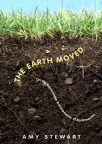- Categories:
Saying It All About the Flower Business
 When author Amy Stewart reads and signs at an independent bookstore, she has a knack for making her visit memorable.
When author Amy Stewart reads and signs at an independent bookstore, she has a knack for making her visit memorable.
Touring a few years ago with her second book, The Earth Moved (Algonquin), Stewart -- who specializes in writing on gardening and on growing things -- showed up at each venue bearing a Tupperware container filled with earthworms.
"I think everyone was a little freaked out about it at first," Stewart recently recalled. "They would hear that I was bringing worms to their store, and they would picture that they would climb up the walls and who knows what." But Stewart's earthy "road show" was quite disciplined -- and very hands-on. "I would get the worms out, and people could hold them... I had little Handi-Wipes, so everyone could clean up their hands afterward... And I would actually give [the worms] away at the end of a leg of the book tour; someone could adopt them and take them home."

"It turns out that people in the flower industry are very generous with their flowers, and very much want to put flowers in people's hands," Stewart said by phone from Chicago, one of the first stops on her current tour. "So I have a few growers who have offered to ship flowers to my events."
Stewart, a Texas native who has long lived in Northern California, became well-acquainted with all aspects of the flower trade in the course of her year's research for Flower Confidential, a work Kirkus Reviews calls "an engaging mix of botany, history, and commerce."
 "I went to Ecuador," Stewart said, "which I loved... And I went to Holland, which is sort of the birthplace of the flower trade, and in some ways they still dominate the flower trade: They may not produce the most flowers, but they're the ones exporting the technology, and developing a lot of the new varieties that are sent around the world to be grown; and the Dutch flower auction is just an unbelievable experience: to be surrounded by that many flowers -- hundreds and thousands of flowers at one time -- is just extraordinary."
"I went to Ecuador," Stewart said, "which I loved... And I went to Holland, which is sort of the birthplace of the flower trade, and in some ways they still dominate the flower trade: They may not produce the most flowers, but they're the ones exporting the technology, and developing a lot of the new varieties that are sent around the world to be grown; and the Dutch flower auction is just an unbelievable experience: to be surrounded by that many flowers -- hundreds and thousands of flowers at one time -- is just extraordinary."
Stewart traveled to Miami to watch flowers arrive at the airport for Valentine's Day (florists' biggest day of the year) and journeyed to Manhattan, and all over California, to witness every aspect of the floral business.
"When I started out," she said, "my goal was, from the perspective of an ordinary consumer, to trace the flowers' journey from seed to store... and understand the sort of narrative arc of their life."
But amid the vivid tableaux, Stewart discovered a cut-flower industry in the midst of significant transitions.
"The whole flower industry is trying to figure out, how can we get people to buy more flowers? How can flower shops stay alive?" she explained.
"In some ways, I saw some parallels with what independent bookstores go through... flower shops are having to deal with competition from grocery stores, and from Costco and Wal-Mart -- outlets that are selling mass-market flowers at severely discounted prices; and it's hard for [flower shops] to get consumers to understand that what they have to offer is maybe a more diverse and interesting selection," in addition to a level of consumer service those giant retail outlets cannot match.
"The other thing that's going on in this industry right now," Stewart noted, "is that they're having to deal with environmental and labor issues. I think there's kind of a 'Green revolution' happening right now in the flower trade."
Stewart wraps such descriptions and discoveries ("You know we import 78 percent of the flowers that we buy in this country?") in compelling prose that reviewers have termed "lush," "passionate," and "infectious." Her inspirations in crafting that prose, she said, are such "great narrative nonfiction writers" as Michael Pollan ("[It's interesting] to look at where he places himself in the story as the narrator; this is a critical thing, for a writer who does the kind of work that I do") and Sue Hubbell ("[She] does a great job of figuring out exactly how much information to give you [on a subtopic], before she goes back to her story.")
 Stewart's most personal literary touchstone, though, is a legendary New Yorker author. "The writer who I keep on my desk all the time, just for sheer inspiration, is E.B. White. His work is just stunning to me," she explained. "I think every writer keeps a few books on [his or her] desk that have nothing to do with the work that they're doing -- but [these works are] so lyrical, and there's just something about their voice, that you can open up to any page and read a few paragraphs and go, 'Okay okay, I think I can do this.'"
Stewart's most personal literary touchstone, though, is a legendary New Yorker author. "The writer who I keep on my desk all the time, just for sheer inspiration, is E.B. White. His work is just stunning to me," she explained. "I think every writer keeps a few books on [his or her] desk that have nothing to do with the work that they're doing -- but [these works are] so lyrical, and there's just something about their voice, that you can open up to any page and read a few paragraphs and go, 'Okay okay, I think I can do this.'"
Now, having completed her third book (the first, for the record, being From the Ground Up: The Story of a First Garden, Algonquin), Stewart has left her desk (and garden) and once more hit the road -- armed with bouquets.
"I'm so excited to be starting this tour," she said, "and get to visit so many great bookstores... independent bookstores have obviously meant so much to me, over the years. And the Book Sense thing -- I was so happy about that, I said to my husband: 'If nothing else happens about this book, I'm done! I'm done! That's all I wanted.'" --Tom Nolan

